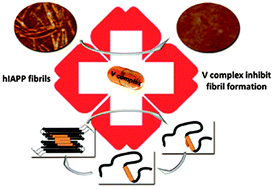Inhibition of human amylin fibril formation by insulin-mimetic vanadium complexes†
Abstract
The toxicity of amyloid-forming proteins can be linked to many degenerative and systemic diseases. Human islet amyloid polypeptide (hIAPP, amylin) has been associated with type II diabetes. Methods for efficient inhibition of amyloid fibril formation are highly clinically important. This study demonstrated the significant inhibitory effects of six vanadium complexes on hIAPP aggregation. Vanadium complexes, such as bis(maltolato)-oxovanadium (BMOV), have been used as insulin-mimetic agents for the treatment of diabetes for many years. Different biophysical methods were applied to investigate the interaction between V complexes and hIAPP. The results indicated that the selected compounds affected the peptide aggregation by different action modes and protected the cells from the cytotoxicity induced by hIAPP. Both the high binding affinity and the ligand spatial effect on inhibiting hIAPP aggregation are significant. Although some of these compounds undergo biotransformation under the conditions of the experiments, and the active species are not identified, it is understood that the effect results from a particular compound and its conversion products. Importantly, our work provided information on the effects of the selected V complexes on hIAPP and demonstrated multiple levels of effects of V complexes against amyloid-related diseases.


 Please wait while we load your content...
Please wait while we load your content...